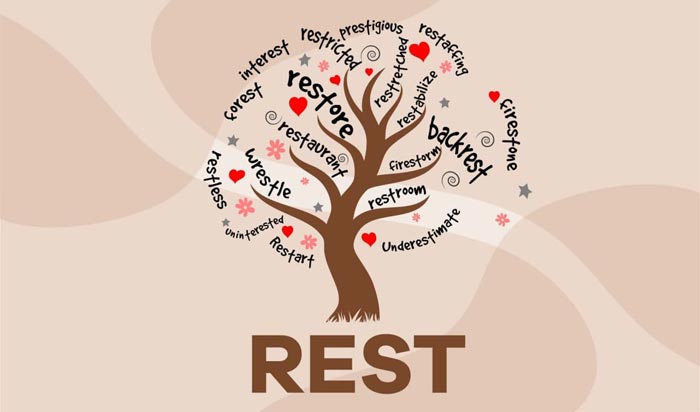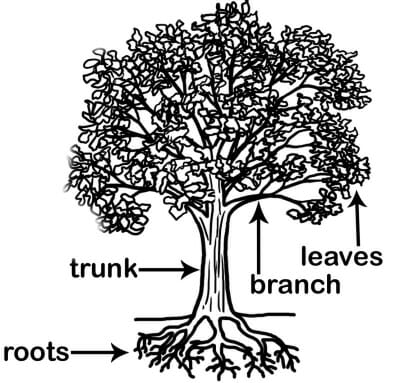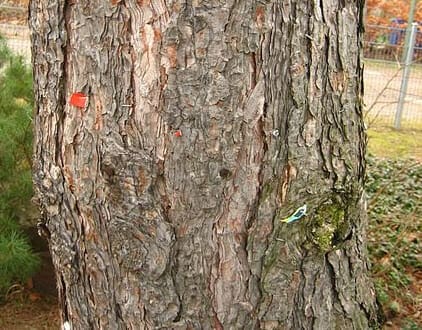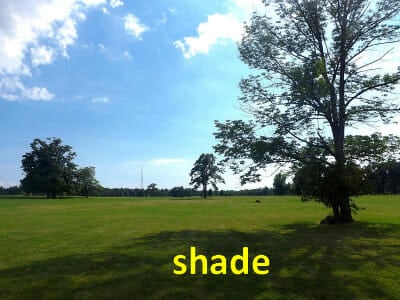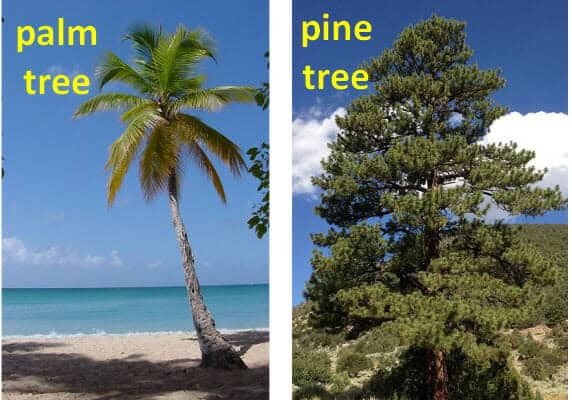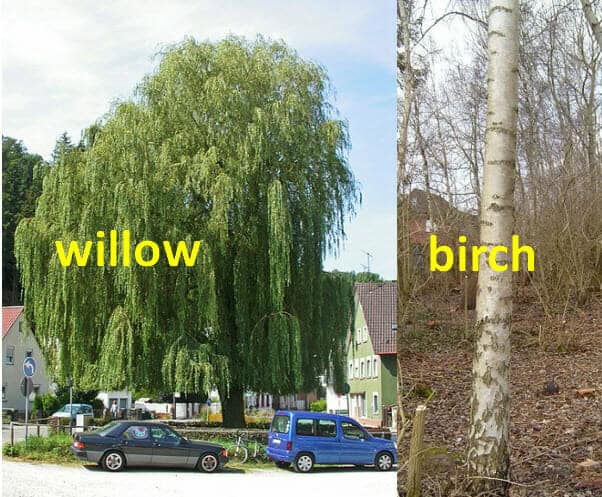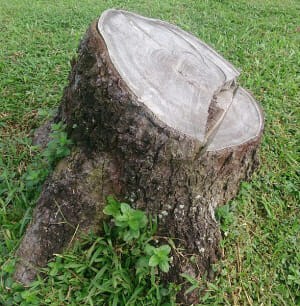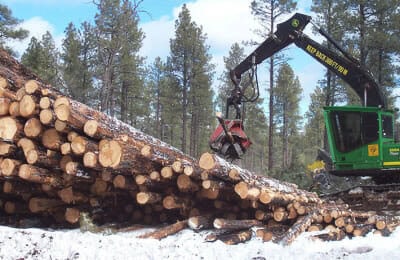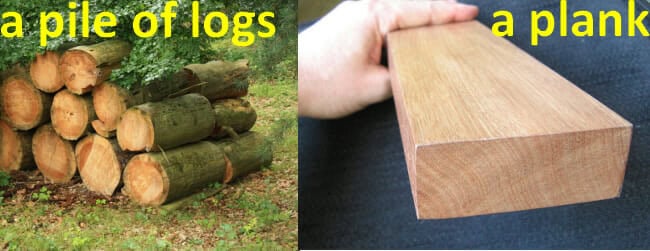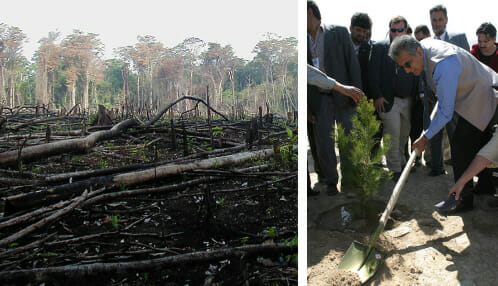This material is intended as pronunciation help for learners of English. The material contains lists of names of trees, with phonetic transcription and Russian translation. Examples of use in sentences are provided at the end of this material.
Usually, the name of a tree is also used as the name of its wood and, in the case of fruit trees, as the name of its fruit. For example, «cherry» may refer to the fruit of a cherry tree, to the cherry tree itself, and also to its wood.
The word «tree» is often added to the names of trees: fir tree, fir trees; pine tree, pine trees; oak tree, oak trees; birch tree, apple tree, walnut tree, etc. (Such words may also be spelled with a hyphen: fir-tree, pine-tree, oak-tree, etc.)
Plural forms of the names of trees are generally formed according to the rules: oak, oaks; fir, firs; spruce, spruces; olive, olives; acacia, acacias; cherry, cherries. Some irregular (or difficult) plural forms are indicated in the lists below.
(Formation of plural nouns is described in Adding the Ending s/es to Nouns and Verbs and Irregular Plural Nouns in the section Writing.)
Note: Names of fruits, vegetables, nuts, herbs and spices are provided in Food Products Main List in the section Vocabulary.
Данный материал предназначен как помощь по произношению для изучающих английский язык. Материал содержит списки названий деревьев, с фонетической транскрипцией и русским переводом. Примеры употребления в предложениях даны в конце этого материала.
Обычно, название дерева также используется как название его древесины, а в случае фруктовых деревьев, и как название его плода. Например, «cherry» может относиться к плоду вишнёвого дерева, к самому вишнёвому дереву, а также к его древесине.
Слово «tree» часто добавляется к названиям деревьев: fir tree, fir trees; pine tree, pine trees; oak tree, oak trees; birch tree, apple tree, walnut tree и т.д. (Такие слова могут также быть с дефисом: fir-tree, pine-tree, oak-tree и т.д.)
Формы множественного числа названий деревьев обычно образуются по правилам: oak, oaks; fir, firs; spruce, spruces; olive, olives; acacia, acacias; cherry, cherries. Некоторые неправильные (или трудные) формы мн. числа указаны в списках ниже.
(Образование множественного числа существительных описывается в материалах «Adding the Ending s/es to Nouns and Verbs» и «Irregular Plural Nouns» в разделе Writing.)
Примечание: Названия фруктов, овощей, орехов, трав и специй даны в материале «Food Products Main List» в разделе Vocabulary.
Transcription symbols in this material
[p], [b], [t], [d], [k], [g], [f], [v], [θ], [ð], [s], [z], [sh], [h], [ch], [j], [m], [n], [ŋ], [l], [r], [w];
[i:], [i], [e], [æ], [a:], [o:], [o], [u:], [yu:], [u], [ʌ], [ə], [ər]; [ei], [ai], [au], [ou];
[θ] as in THINK; [ð] as in THIS; [sh] – SHE; [ch] – RICH; [j] – JANE; [ŋ] – LONG;
[a:] as in CAR; [æ] as in CAT; [i:] – SEE; [i] – ILL; [e] – GET; [o:] – MORE; [o] – LOT;
[u:] as in BLUE; [yu:] as in USE; [u] – BOOK; [ʌ] – CUT; [ə] – AWAY; [ər] – SIR;
[ei] as in DAY; [ai] as in MINE; [au] – OUT; [ou] – GO; [y] as in YES.
Transcription is indicated according to American pronunciation. Stress is indicated before stressed syllables. Example of secondary and primary stress before stressed syllables: [,yu:kə’liptəs] (eucalyptus).
Транскрипция указана согласно американскому произношению. Ударение указано перед ударными слогами. Пример второстепенного и главного ударения перед ударными слогами: [,yu:kə’liptəs] (eucalyptus).
Parts of a tree
trunk [trʌŋk] – ствол; stem – ствол; стебель; stalk [sto:k] – стебель;
branch [brænch] (AmE), [bra:nch] (BrE) – ветка, ветвь;
limb [lim] – большая ветка; bough [bau] – сук; bark [ba:rk] – кора;
twig – веточка; маленькая ветка; shoot [shu:t] – росток, побег; молодая веточка;
flower – цветок; blossom [‘blosəm] – цвет, цветение; цветок (особ. плодовых деревьев);
catkin [‘kætkin] – серёжка (соцветие); bud [bʌd] – почка;
fruit [fru:t] – плод; seed [si:d] – семя, семечко; seeds – семена;
leaf [li:f] – лист; leaves [li:vz] – листья; foliage [‘fouliij] – листва, листья;
treetop [‘tri:,top] – верхушка дерева; crown [kraun] – крона;
root [ru:t] – корень; stump [stʌmp] – пень.
Kinds of trees
coniferous [kə’nifərəs], [kou’nifərəs] – хвойный; шишконосный;
coniferous tree – хвойное дерево;
conifer [‘kounəfər], [‘kounifər], [‘konəfər] – хвойное дерево;
evergreen [‘evərgri:n] – вечнозелёный; вечнозелёное растение;
deciduous [di’sijuəs] – листопадный;
deciduous trees – листопадные деревья;
broad-leaved trees, broadleaf trees – широколиственные деревья;
perennial plant [pə’reniəl ‘plænt] – многолетнее растение.
Coniferous trees
pine [pain] – сосна; cedar [‘si:dər] – кедр;
fir [fər] – 1. пихта; 2. ель;
spruce [spru:s] – ель; spruce fir [‘spru:s ‘fər] – ель.
Some species and varieties
cedar pine – сосна кедровая сибирская;
Scotch pine – сосна лесная (сосна обыкновенная);
white pine – сосна белая; red pine – сосна красная;
cedar of Lebanon – ливанский кедр;
white cedar – белый кедр (туя западная);
noble fir [‘noubl ‘fər], [‘noubəl ‘fər] – пихта благородная;
balsam fir [‘bo:lsəm ‘fər] – пихта бальзамическая;
silver fir – пихта европейская (пихта благородная);
Douglas fir [‘dʌgləs ‘fər] – Дугласова пихта (также наз. Douglas pine, Douglas spruce);
Siberian fir [sai’bi:riən ‘fər] – пихта сибирская;
Siberian spruce – ель сибирская;
European spruce (Norway spruce) – ель европейская; ель обыкновенная;
blue spruce [‘blu: ‘spru:s] – ель голубая;
white spruce – ель белая; red spruce – ель красная.
Other conifers
hemlock [‘hemlok], также hemlock spruce [‘hemlok ‘spru:s] – тсуга (хвойное дерево семейства сосновых);
larch [la:rch] – лиственница;
yew [yu:] – тис (тисс);
redwood [‘redwud] – 1. красное дерево; 2. секвойя;
sequoia [si’kwoiə] – секвойя;
cypress [‘saiprəs] – кипарис;
juniper [‘ju:nəpər], [‘ju:nipər] – можжевельник;
thuja [‘θu:jə] – туя.
Примечание: Hemlock
В американском английском, названия «hemlock, hemlock tree, hemlock spruce» имеют в виду американское хвойное дерево семейства сосновых. В британском английском, «hemlock» – ядовитое растение болиголов.
Примечание: Christmas tree; New Year tree
рождественская ёлка (дерево) – Christmas tree; новогодняя ёлка (дерево) – New Year tree;
рождественская ёлка (празднование) – Christmas party;
новогодняя ёлка (празднование) – New Year party; New Year celebration.
Cones, needles
fir cone [koun] – еловая или пихтовая шишка;
spruce cone – еловая шишка; pine cone – сосновая шишка;
fir needles [‘ni:dlz] – еловые или сосновые иглы, хвоя;
spruce needles – еловые иглы; pine needles – сосновые иглы;
cedar nuts – кедровые орехи; juniper berries – можжевеловые ягоды.
Evergreen trees
coniferous trees (except larch) – хвойные деревья (кроме лиственницы);
eucalyptus [,yu:kə’liptəs] – эвкалипт; мн. число: eucalypti; eucalyptuses;
palm [pa:m] – пальма;
box, boxwood [‘boks,wud] – самшит;
citrus trees [‘saitrəs ,tri:z] – цитрусовые деревья (orange, lemon, etc. – см. Fruit trees);
olive [‘oliv] – маслина, олива, оливковое дерево;
allspice tree [‘o:lspais] – гвоздичное дерево; пряность: allspice – гвоздика, перец гвоздичный душистый;
clove tree [‘klouv] – гвоздичное дерево; пряность: cloves – гвоздика;
laurel [‘lo:rəl], [‘lorəl] – лавр, лавровое дерево;
bay laurel [‘bei ,lorəl], bay tree – лавр благородный, лавровое дерево; пряность: bay leaf – лавровый лист;
cacao [kə’ka:ou], cacao tree – какао (дерево); cocoa [‘koukou] – какао (напиток);
sandalwood [‘sændəl,wud] – сандаловое дерево;
magnolia [mæg’noulyə], [mæg’nouliə] – магнолия (evergreen or deciduous);
acacia [ə’keishə] – акация (evergreen or deciduous);
locust tree [‘loukəst,tri:] – псевдоакация; белая акация (deciduous);
mimosa [mi’mousə], [mi’mouzə] – мимоза (серебристая акация);
rubber plant, rubber tree [‘rʌbər] – каучуконос (гевея бразильская и др.);
holly [‘holi] – падуб остролистный.
Deciduous trees
oak [ouk] – дуб (deciduous or evergreen); acorn [‘eiko:rn] – жёлудь;
birch [bərch] – берёза;
larch [la:rch] – лиственница;
maple [‘meipl], [‘meipəl] – клён;
poplar [‘poplər] – тополь;
willow [‘wilou] – ива; weeping willow [‘wi:piŋ ‘wilou] – плакучая ива;
ash [æsh] – ясень; white ash – ясень белый;
mountain ash [‘mauntən ,æsh] – рябина обыкновенная;
rowan [‘rouən], [‘rauən] – рябина (европейская);
aspen [‘æspən] – осина (также наз. quaking aspen, trembling aspen);
lime tree [‘laimtri:] – липа; linden [‘lindən] – липа;
basswood [‘bæswud] – липа (американская);
alder [‘o:ldər] – ольха; black alder – ольха чёрная;
elm [elm] – вяз, ильм; American elm; English elm;
plane [plein], plane tree – платан; buttonwood [‘bʌtənwud] – платан;
sycamore [‘sikəmo:r] – платан, чинар;
palisander [,pæli’sændər], [‘pæli,sændər] – палисандр, палисандровое дерево;
teak [ti:k] – тик, тиковое дерево;
beech [bi:ch] – бук, буковое дерево (deciduous or evergreen);
hornbeam [‘ho:rnbi:m] – граб;
ironwood [‘aiərnwud] – железное дерево;
baobab [‘beiəbæb] – баобаб.
Fruit trees
fruit tree [‘fru:t,tri:] – плодовое дерево, фруктовое дерево;
apple tree [‘æpl,tri:], [‘æpəl,tri:] – яблоня;
pear [peər] – груша;
cherry tree [‘cheri] – вишня;
apricot tree [‘æprəkot], [‘eiprikot] – абрикос;
peach tree [pi:ch] – персик;
plum tree [plʌm] – слива;
orange tree [‘orinj], [‘orənj], [‘o:rinj] – апельсиновое дерево;
lemon tree [‘lemən] – лимонное дерево;
lime tree [‘laim] – лайм (дерево рода цитрус);
grapefruit [‘greipfru:t] – грейпфрут; также наз. pomelo [‘poməlou];
tangerine [,tænjə’ri:n] – мандарин;
pomegranate [‘pom,grænit] – гранат (дерево, кустарник);
fig tree [fig] – инжир, фиговое дерево;
persimmon [pər’simən] – хурма;
date palm [‘deit ,pa:m] – финиковая пальма;
mango [‘mæŋgou] – манго, манговое дерево; мн. число: mangoes, mangos [‘mæŋgouz];
avocado [,ævə’ka:dou] – авокадо; мн. число: avocados [,ævə’ka:douz];
papaya [pə’pa:yə] – папайя (дерево, кустарник);
mulberry [‘mʌl,beri], [‘mʌlbəri] – шелковица, тутовое дерево.
Nut trees
nutwood [‘nʌt,wud] – ореховое дерево или его древесина;
chestnut [‘chesnʌt], [‘chesnət] – каштан;
walnut [‘wo:lnʌt], [‘wo:lnət] – орех, ореховое дерево (грецкий орех);
almond tree [‘a:mənd,tri:], [‘æmənd] – миндаль;
hickory [‘hikəri] – пекан;
coconut palm [‘koukənʌt,pa:m] – кокосовая пальма (также наз. coconut tree);
cashew [‘kæshu:], [kə’shu:] – орех кешью;
pistachio [pis’ta:shiou] – фисташковое дерево, фисташка;
hazel [‘heizəl] – лещина, лесной орех, орешник, фундук (кустарник, дерево); лесной орех (плод) – hazelnut.
Forest, wood
forest [‘fo:rist], [‘forist] – лес, лесной массив;
pine forest – сосновый бор; oak forest – дубрава;
wood, woods [wudz] – лес, роща (обычно меньше, чем forest);
clearing in the woods – поляна в лесу; edge of a wood – опушка леса; path through the woods – тропинка через лес;
grove [grouv] – лесок, роща (небольшая группа деревьев);
orange grove – небольшая роща апельсиновых деревьев; grove of pines – небольшая сосновая роща;
dense forest – густой лес; thin forest – редкий лес;
woodland – лес, лесистая местность; wooded area – лесистый район.
Types of forests
taiga [‘taiga:], [‘taigə] – тайга; tundra [‘tʌndrə], [‘tundrə] – тундра;
coniferous forests – хвойные леса; evergreen forests – вечнозелёные леса;
broad-leaved deciduous forests – широколиственные листопадные леса;
deciduous forest – листопадный (лиственный) лес; mixed forest – смешанный лес;
tropical forest – тропический лес; tropical rain forest – дождевой тропический лес;
jungle [‘jʌŋgl], [‘jʌŋgəl] – джунгли; savanna, savannah [sə’vænə] – саванна;
undergrowth [‘ʌndərgrouθ] (также, underbrush, underwood) – подлесок.
Botanical garden, national park
botanical garden [bə’tænikəl ‘ga:rdən] – ботанический сад;
national park [‘næshənəl ‘pa:rk] (AmE) – заповедник, национальный парк;
sanctuary [‘sæŋkchuəri], [‘sæŋkchu,eri] – заповедник, заказник;
wildlife sanctuary – заповедник живой природы (для животных, птиц, рыб, растений);
wildlife refuge [‘waildlaif ‘refyu:j] – заповедник живой природы;
bird sanctuary – птичий заповедник; deer park – олений заповедник;
game preserve [pri’zərv] – заповедник дичи; hunting preserve – охотничий заповедник;
nature reserve [‘neichər ri’zərv] – природный заповедник; forest reserve – лесной заповедник.
Wood, lumber, timber
wood – дерево, древесина; wooden [‘wudn], [‘wudən] – деревянный;
hardwood [‘ha:rdwud] – твёрдая древесина; дерево твёрдых пород;
softwood [‘softwud] – мягкая древесина; хвойное дерево или его древесина;
lumber [‘lʌmbər] (AmE) – лесоматериал, пиломатериал; строительный материал;
timber [‘timbər] – лесоматериал, пиломатериал; строевой лес; брус, бревно;
log – бревно; wood pulp [‘wudpʌlp] – древесная масса (в производстве бумаги).
Related vocabulary
Plants
plant [plænt] (AmE), [pla:nt] (BrE) – растение;
vegetation [,veji’teishən] – растительность;
shrub [shrʌb], bush [bush] – куст, кустарник;
grass [græs] (AmE), [gra:s] (BrE) – трава;
herb [ərb], [hərb] – трава; растение (особ. лекарственное);
herbs – травы (лекарственные, пряные, кулинарные);
flower [‘flauər] – цветок; wild flowers – полевые цветы;
genus [‘ji:nəs] – род, вид; мн. число: genera [‘jenərə];
species [‘spi:shi:z], [‘spi:si:z] – вид; виды (мн. число без изменения); род;
varieties [və’raiitiz] – разновидности.
Biology, biologist
biology [bai’oləji] – биология; botany [‘botəni] – ботаника;
horticulture [‘ho:rti,kʌlchər] – садоводство; gardening [‘ga:rdniŋ] – садоводство;
forestry [‘foristri] – лесоводство; лесное хозяйство; лесничество;
biologist – биолог; botanist – ботаник; gardener – садовник; садовод;
forester [‘foristər] – лесник, лесничий; keeper – лесник;
gamekeeper – лесник, охраняющий животных;
logger (AmE) – лесоруб; lumberjack (AmE) – лесоруб, дровосек;
lumberman – 1. лесоруб, дровосек; 2. (AmE) лесопромышленник.
Examples in sentences
Coniferous trees are found throughout the world. Pines usually grow in the Northern Hemisphere. Cedars usually grow in Southwest Asia, in the Himalayas, and in North Africa.
Coniferous forests predominate in the taiga stretching across vast areas in the subarctic zones of Eurasia and North America.
Fir, spruce and pine predominate in the taiga forests of Eurasia. Pine and larch are dominant conifers in East Siberia.
There are about 600 species of coniferous trees. Most conifers are evergreens. Larch is a deciduous coniferous tree.
Ash, birch, lime, maple, oak and plane are deciduous trees. Some species of oak are evergreen trees.
Sequoias are giant evergreen coniferous trees that can grow over 100 meters tall and can reach an age of more than 3000 years.
Oregon’s coniferous trees include Douglas fir, ponderosa pine, Sitka spruce, and hemlock. Forests of spruce, fir, and white pine are dominant in Maine.
Fir trees and spruce trees are often used as Christmas trees. Popular choices for Christmas trees are silver fir, noble fir, balsam fir, Norway spruce, blue spruce.
Fir cones grow upward and are raised on branches; spruce cones hang down from branches.
Common hardwoods include ash, beech, birch, cherry, maple, oak, poplar, teak, and walnut. Common softwoods include cedar, fir, pine, spruce, and lime.
Tropical rain forest contains more than four fifths of all the plant species of the world. The Amazon rainforest, the largest rainforest in the world, contains thousands of plant species.
Banyan trees of India are unusual trees. Their branches send additional roots to the ground and become additional trunks, making the tree spread over a large area.
Хотите узнать названия деревьев на английском с русским переводом? Мы подготовили для вас самый полный список названий хвойных и лиственных деревьев и кустов и их описания на английском языке.
Names of Trees and Shrubs (название деревьев и кустов)
- Береза – Birch
- Дуб – Oak
- Осина – Aspen
- Рябина – Rowan
- Ясень – Ash
- Козья ива – Sallow
- Тополь – Poplar
- Вяз – Elm
- Липа – Lime, linden (AmE)
- Ольха – Alder
- Бузина – Elder
- Лиственнца – Larch
- Сосна – Pine
- Орешник – Hazel
- Каштан – Horse chestnut
- Клен – Maple
- Ива – Willow
- Яблоня – Apple tree
- Слива – Plum
- Вишня – Cherry
- Черемуха – Bird cherry/choke cherry
- Грецкий орех – Walnut
- Груша – Pear
- Ель – Spruce
- Калина – Gueldes rose/May rose (snowball – сорт калины с круглыми белоснежными соцветиями)
- Барбарис – Burberry
- Шиповник – Dog’s Rose
- Ирга – Amelanchier (общее название вида), имеет около 10 названий, в зависимости от вида и
региона употребления: shadbush, shadblow, shadwood, service tree, chuckey pear, wild pear, saskatoon, sugarplum и juneberry – мы пользуемся последним. - Боярышник – Hawthorn
- Облепиха – Sea-buckhorn
- Черноплодная рябина – Aronia, black chokeberry
- Смородина – Currant (black, red, white)
- Малина – Raspberry bush
- Черная малина – Black raspberry bush
- Ежевика – Blackberry bush
- Крыжовник – Gooseberry bush
- Жимолость – Honeysuckle
- Туя – Thuj(y)a
- Кипарис – Cypress
- Акация – Acacia
- Можжевельник – Juniper
General Description (общее описание)
- Деревья бывают разнообразных форм и размеров. – Trees grow in all shapes and sizes.
- У некоторых действительно толстые стволы. – Some trees have really thick trunks.
- Некоторые леревья тонкие. – Some trees are skinny.
- Некоторые представляют собой кусты. – Some are bushes/shrubs.
- Этот холм зарос кустарником. – This hillock is overgrown with shrubs.
- Это чаще всего выглядит больше как кустарник, чем как дерево. – This one often grows as a bush rather than a tree.
- У дерева длинный (высокий) ствол. Листья и ветки начинают расти на большой высоте (напр. сосна) – The tree has a tall trunk. Leaves and branches grow from a long way up.
- Это дерево не вырастает намного крупнее куста. – This tree doesn’t grow much bigger than a bush.
- Это дерево может быть больше в ширину, чем в высоту (с раскидистой кроной). – This tree can grow wider than it is tall.
- Это дерево любит жить во влажных местах (напр. ива) – The tree likes to live in wet places.
- Это дерево с круглой кроной. – This is a round headed tree.
- Это – раскидистое. – This one is branchy/ spreading tree.
Описание хвойных деревьев на английском с переводом
- Общее название для таких деревьев – хвойные (вечнозеленые). У них игловидные листочки. – Common name for this kind of trees is conifers (=evergreen trees). They’ve got needle-like leaves.
- Хвойные деревья это те, у которых семена в шишках. У них иголочки вместо листьев, и многие из них дерево сохраняет зимой. – Coniferous trees are trees that produce cones as seeds. These trees have needles instead of leaves and will retain many of their needles during the winter.
Описание лиственных деревьев на английском языке с переводом
- Листья лиственных деревьев меняют цвет и опадают зиимой. Их семена формируются в плодах, орехах, стручках и ягодах. – Leaf-bearing trees (= deciduous/ broad-leaved trees) have leaves that change color and drop off for the winter. Their seeds grow inside fruit, nuts, pods and berries.
- Это дерево может жить до…лет. – These trees can live for as long as…years.
- Эти деревья часто растут как изгородь. – These trees often grow as garden hedges.
- Давай рассмотрим деревья поближе. – Let’s watch trees up close.
- Многие деревья выглядят похожими издалека. Приблизься, и ты начнешь видеть (узнавать) отличия. – Many trees look the same from a distance. Up close, you will start to recognize differences.
- У этого дерева ровная шарообразная крона. – This tree has regularly rounded crown.
- Ствол этого терева узловатый и изогнутый. – The trunk of this tree is knotty and twisted.
- Вот дерево с огромной кроной и прямым стволом (напр. сосна) – Here is a large-crowned tree with a straight trunk (pine).
- Вот маленькое низкорослое скрюченное деревце с короткими веточками. – Here is a small, scrubby, twisted tree with short limbs.
- Деревья выпускают листочки весной. – Trees are leafing out in spring.
- Оченью листья высыхают, становятся желтоватыми и опадают на землю. – In Autumn (Fall) leaves get dehydrated, turn yellowish and fall down on the ground.
- Зимой некоторые деревья могут выглядеть, как мертвые коряги. На самом деле они просто спят. – In winter some trees may look like dead snags. In fact they’re just asleep.
- Некоторые птицы используют деревья для постройки гнезд (деревья держат гнезда). Другие, как, например, совы и ястребы, среди деревьев ищут добычу. – Some birds use trees to hold their nests. Others, such as owls and hawks, use trees to find their food.
- Деревья обеспечивают защиту и пропитания многим представителям животного мира. Белки используют их как транспортную систему. Ты можешь увидеть, как они прыгают с ветки на ветку. – Trees provide shelter and food to wildlife. Squirrels use trees as part of their
transportation system. You can see them jumping from branch to branch as they travel. - Пока у дерева все листья на месте, он обеспечивает тенью и укрытием многих животных. – When a tree has all its leaves, it will provide shade and shelter to many animals.
Tree Life Cycle (жизненный цикл)
- Семя – Seed
- Побег – Shoot
- Росток – Sprout
- Побег, молодое деревце – Sapling
- Взрослое,окончательно сформировавшееся дерево – Mature tree/grown-up tree
- Засохшее дерево – Snag
- Гниющий пень/бревно Rotting – stub/log
- Дерево дает побеги, прорастает. – The tree is sprouting out
- Функции частей дерева – Tree Parts’ Functions
- У корней две задачи: удерживать (как якорь) дерево в земле, а также впитывать воду и
питательные вещества из почвы. – Roots have two jobs – to anchor the tree to the earth and to absorb water and nutrients from
the soil. - Корни – это подземные «ветви», которые обеспечивают дерево водой (подтягивают воду) и
питанием из почвы. – Roots are the “underground” branches that pull up water and food for the tree from the soil. - Корни удерживают дерево на месте. – Roots hold the tree in place.
- Крона – это верхушка дерева, где мы может видеть из ветви, листья, семена и цветы. – The crown is the top of the tree where we can find the branches, leaves, seeds and flowers.
- Ствол – это стебель дерева, покрытый корой для защиты. – The trunk is the stem of the tree covered with bark to protect it.
- Но позволяет веткам дотянуться до солнца (держит ветви в солнцу). – It holds the branches towards the sunlight.
- Ствол помогает питательным веществам проходить от корней к веткам. – Trunk helps food to travel between the roots and the branches.
- Листья обеспечивают растение пищей (питательными веществами) и воздухом, чтобы
они могли оставаться здоровыми и расти. – Leaves provide food and air to help a plant stay
healthy and grow. - В процессе фотосинтеза листья превращают питательные вещества в энергию. Через поры
листья «вдыхают» углекислый газ и «выдяхают» кислород. Листья также освобождают растение от излишней влаги. Это похоже на процесс выделение пота (у людей). – Through photosynthesis, leaves turn light energy into food. Through pores leaves “breathe” in carbon dioxide and “breathe” out oxygen. Leaves also release excess water. It is much like sweat. - Кора – Bark
- Кора – самый верхний слой ствола, который защищает дерево. – Bark is the outermost layer that protects the tree.
- Текстура коры может варьироваться от гладкой, глянцевой, слегка бугристой до хребтообразной (очень грубой) – Textures of bark vary from being smooth, shiny, and slightly bumpy to being ridged (extremely rough).
- пятнистая кора – mottled bark
- волокнистая – fibrous and stringy
- черноватая, грубая, с чешуйками – blackish, rough, and scaly
- Темно-коричневая кора – dark brown bark
- серебристо-белый ствол – silvery-white trunk
- слоистая/чешуйчатая кора – flaky bark
- Не коре старых деревьев могут образовываться глубокие трещины. – Old trees can have deep cracks in their bark.
- Гладкая кора с глубокими трещинами – smooth bark with deep cracks
- Кора образует широкие ленты вокруг ствола дерева. – Bark splits into thick bands around a tree.
- Кора имеет трещины, которые закручиваются/извиваются вокруг ствола (по форме ствола). – Bark has cracks that twist around the tree
- Неоднородная кора на стволе (как заплатки) – Patchy bark on the trunk
шероховатый – scratchy - Грубый и древянистый – rough and woody
- Полоски коры облезают – Strips of bark peel off
- Кора отходит кусками/заплатками – Bark exfoliates in patches
- Кора – пестрая смесь коричневых, желтых и зеленых оттенков. – Bark is a patchwork of browns, yellows and greens.
- Эта кора испещрена желобками, которые разделяют ее на плоские чешуйчатые пластины (о сосне). – This bark is deeply grooved into flat, flaky plates (pine)
- По мере роста дерева кора становится толще. Она становится очень грубой, практически черной и шарокими чешуйчатыми пластинками. – As the tree matures, the bark becomes thicker. It gets very rough, and nearly black, with wide scaly plates.
- Плоды – Fruits
- Желуди – Acorns
- Желуди растут на ножке (стебельке, черешке). – Acorns grow on stalks.
- Желуди матереют/зреют (становытся крупнее). – The acorns are maturing
- Дуб прорастает из желудя. – The oak is sprouting from its acorn.
- Желуди «пухнут» (зреют, увеличиваются в размере). – The acorns are plumping out.
- Ягоды – Berries
- Плоды этого дерева ягодообразные. – This tree has berry-like fruit.
- Эти круглые черно-синие ягоды часто покрыты белой пылью/налетом ( о налете, который можно наблюдать на игре, чернике). – These round blue-black berries often covered in white dust/bloom.
- Вот горсть ярко-красных блестящих ягод. – Here is a bunch of bright red shiny berries.
- Яблоки (ягоды) становятся крастыми или желтыми по мере созревания. – Apples (berries) turn red or yellow as they ripen.
- Вот длинная гроздь темно-фиолетовых ягод (черемуха) – Here’s a long cluster of dark purple berries (bird cherry/choke cherry).
- Сережки – Catkins
- Сережки – это, по сути, плотно прижатые друг к другу цветы. – Catkins are actually flowers packed together.
- Эти выглядят очень похожими на шашки, но, на самом деле, это одеревеневшие сережки (ольха) – These look very much like cones, but in fact they’re woody catkins (alder)
- На сережках появляются пушистые,опушенные семена (тополь, ива). – Fluffy seeds appear on catkins.
- Сережки выпускают опушенные семена. – Catkins drop fluffy seeds.
- Сережки тополя выпускают пушистые семена. – Poplar catkins release fluffy white seeds.
- Березовые сережки легко рассыпаются. – Birch catkins fall apart easily.
- Если погладить пушистые серые сережки, они такие же мягкие на ощупь, как мех кошки. – If you stroke furry gre(a)y catkins they feel as soft as a cat’s fir.
- Орехи – Nuts
- Каждый круглый зеленый плод содержит орех. – Each round green fruit contains a nut.
- Орешки здеют в скорлупе. – Nuts ripen in their shells.
- Орешки выпадают из оболочек осенью. – Nuts drop from their cases in autumn.
- морщинистый орех (грецкий) – crinkly nut
- У орешков колючие оболочки/скорлупа. – Nuts have spiny shells.
- Эти блестящие орешки называются «каштан». – Shiny nuts are called conkers.
- Каштаны растут в колючих оболочках. – Conkers grow in prickly cases
- Прицветники – Bracts
- Это прицветники. Бывает, они выглядят, как цветы, но на самом деле они скорее листья. – These are bracts.
- They may look like flower petals, but in fact those are modified leaves.
- У липы прицветники в виде полоски. – This tree (lime/linden) has strap-like brats.
- Шишки = Cones
- Это дерево можно опознать по шишкам. – You can spot this tree by its little cones.
- Здесь шишка имеют яйцеобразную форму/удлиненную (ель), а здесь – округлую (лиственница). – Here cones are egg-shaped/prolonged (spruce), here – round (larch).
- Эти шишки мясистые и похожи на ягоды (можжевельник). – There cones are flashy and berry-like (juniper).
- Длинные коричневые шишки с чешуйками. – Long brown cones with scales.
- Более молодые шишки растут ближе к верхушке. – Youngest cones grow closer to the top
- Семена плотно уложены в шишке. – Seeds are packed tightly inside a cone.
- Крылатки (вертолетики) – Keys (helicopters)
- У семян есть маленькие крылышки, которые помогают им улетать (от дерева) – Seeds have little wings to help them fly away (from the parent-tree).
- Два семечка соединены вместе. – Two seeds are stuck together.
- У каждого семечка есть небольшое крыло. – Each seed has a little wing.
- Семена называются «крылатки» и свисают небольшими гроздьями. – Seeds are called keys and hang in little bunches.
- Листья – Leaves
- Иглообразные (хвойные) – Needle-like (conifers)
- Новые иглы мягкие и зеленые, они становятся желтыми осенью (о лиственнице). – New needles are soft and green, turning golden yellow in the fall/in Autumn. (larch)
- У это дереве иглообразные листья, которые не опадают (остаются на дереве) круглый год. – This tree has needle-like leaves that stay on the tree whole year round.
- Иголки на конце ветки направлены в разные стороны/вверх. – Needles on upper part of the twig point sideways/upwards.
- Дерево скидывает всю листву к зиме. – The tree drops all of its leaves in winter.
- Иглообразные листочки растут парами. – Needle-like leaves grow in pairs.
- Лиственные – Broad-leaved-trees
- Листья меняют цвет и зеленого на золотой, прежде чем опасть. – Leaves change color from green to gold before
they fall. - Листочки пости круглые (осина). – Leaves are almost round (aspen)
- Листья имеют зигзаггообразные края (береза). – Leaves have zig-zag edges (birch)
- Осенью листья становятся рыжими и желтыми. – In autumn (fall) leaves turn orange and yellow
- Остроконечные листья в крупными прожилками (тополь). – Pointed leaves with big veins (poplar)
- Гладкие листья и волнистыми краями (осина, дуб). – Smooth leaves with wavy edges (oak, aspen)
- Стороны листа присоединяются к черенку в разные местах (вяз). – Two sides of a leaf join the stem in different
places (elm). - Пары листьев растут ровно друг напротив друга (рябина). – Pairs of leaves grow opposite each other (rowan).
- Листья в фрме сердца (липа) – Heart-shaped leaves (lime)
- Шипы на листьях смотрят в разные стороны. – The spines on the leaves point at different directions
- Листья колышутся/шелестят на ветру. Звук похож на шепот (осина). – Leaves flutter/tremble in the breeze. It sounds as if they are whispering (aspen)
- Потрогай этот литсок. Он пушистый с внутренней стороны (брядина, яблоня). – Touch this leaf. It has got hairy underneath (apple-tree, sallow)
- У листочков с обратной стороны есть волоски. – Leaves have little hears underneath
- Округлые листья с зубчатыми краями (осина) – Rounded leaves with jagged edges (aspen)
- Широкие листья с острым кончиком (липа) – Broad leaves with pointy tips (lime)
- Черенок листа красноватый/коричневые – Leaf stems are reddish/brown
- Листья могут вырасти крупнее, чем твоя рука/ладонь. – Leaves can grow bigger than your hand/palm.
- У листьяе закругленные края – Leaves have rounded edges
- Длинные тонкие листья с небольшими остроконечными зубцами (рябина) – Long slim leaves with little pointy teeth (rowan)
- Крупные листья, которые похожи на руку великана (каштан) – Big leaves that look like giant’s fingers (horse chestnut)
- Листья раскрываются (из почек) – Leaves are unfurling
- Эти молодые листики были «запакованы» в почке – These young leaves were packet in the bud
- Листья гармошкой/гафрированные (орешник, вяз) – Pleated leaves
- Здесь листья растут пучками – Here leaves grow in bundles
- Эти листья растут друг напротив друга на ветке (рябина, ясень, шиповник). – These leaves grow opposite each other on a twig.
- Здесь листики чередуются (со смещение относительно предыдущего). Можешь найти другие деревья, листья которых имеют похожее расположение? – Leaves are alternating here. Can you spot more trees with the same kind of leaves’ orientation?
- Листья этого дерева широкие без зазубрин = не
разделенные на сегменты. – Leaves of this tree are broad without indentations (проверочное слово dent – зуб:) =
lot lobed - Эти листья неровной формы = разделенные на сегменты (клен, дуб, каштан). – These are irregularly shaped = lobed
- Здесь листочки на ветках выглядят как плоские веерообразные побеги (кедр, туя). – Here leaves are arranged on the twigs in flat, fan-like sprays (thuya, cedar)
- Малюсенькие остроконечные листики, сплюснутые вместе. – Tiny pointy leaves squashed together
- Семена/листья/плоды разбросаны/раскиданы по земле. – Seeds/leaves/fruit are scattered on the ground..
- Ветки и прутики – Branches and twigs
- Эти ветки покрыт острыми шипами. – These branches are covered with sharp thorns.
- Это очень колючий куст. – It’s a very prickly bush.
- Молодые ветви с листиками связываются в пучок и используются в русской бане. – Young twigs with leaves are bundled up and traditionally used in Russian sauna.
- На концах веток этого дерева четные почки. – There are black buds on tips of its twigs.
- Ветки покрыты (снабжены, вооружены) длинными колючками. – Branches are armed with long prickles.
- Эти веточки шершавые/чешуйчатые. – These branches are scaly.
- Эти крепкие, гладкие и блестящие. – These are very stout, smooth, shining.
- Эти искривленные и корявые. – These are crooked and twisted.
- Пчелы любят пить нектар из цветов. – Bees like drinking flowers’ nectar.
- Деревья цветут белым цветом (выпускают цветки) весной. – Trees sent out white blossom in Spring.
- Дюжины мелкий цветочков цветут рядом. – Dozens of little flowers grow close together.
- Белые цветы появляются раньше, чем листья. – White flowers come out before leaves.
- Пчелы собирают пыльцу и переносят ее с цветка на цветок. – Bees gather pollen and transport it from flower
to flower. - цвести – To flower/blossom/bloom
- Цветы появляются весной. – Flowers are emerging in Spring.
- Цветы источают сладкий аромат. – Flowers send their sweet fragrance forth.
За материал благодарим Анастасию Борисову и проект english4.me
Learning new words in a language is always a tough job. Mounting the words to be learnt in a relatable order with the help of the graphic resource of a tree eases the process. The tree would house necessary definitions and information about those words so that in a compact graphic scenario all the listed words work better for the learner. All this makes learning new words easy and durable. Learning new vocabulary begets hours of practice over a long period of time.
What is a Vocabulary Tree?
Vocabulary tree is a visual organizer to learn/teach new words in a language. Holding the tree theme constant, the root of it would have the root word or morpheme, branches would have the words that stemmed out of that particular word and the leaves can have short descriptions of each branched out the word.
Vocabulary trees are used in schools to teach new words to children. The method of word formation becomes imminent in the vocabulary tree. The whole mechanism of the words being formed with a root word is portrayed graphically in the vocabulary tree setup.
Vocabulary Tree vs Word Lists
Word list is a list of new words with their meanings in the source language of the learner. These lists are the oldest prop in the language learning book to learn vocabulary effectively. People are used to learning words in lists of manageable size. One or two lists a day. Word lists have been working well for many but putting those lists into a graphically organized form of a tree lets people memorize them more easily.
The graphic element in the vocabulary tree tends to be more effective for the learners as they pick up on the visual cues far easier than normal. One might say listing words in specific orders is one kind of visual cue in itself. But experience will tell you that visual cues consisting of pictures are more effective in this case. Vocabulary tree wins this fight off against the word list.
How to Make a Vocabulary Tree?
Making a vocabulary tree depends on a certain level of expertise in the target language on the creator’s part. The learners aim for a similar level of expertise as well. Taking print-out of the picture of a tree and laminating it will allow you to draw and write on it with a marker over and again. But you can choose to draw your own new tree every time you stick vocabulary to it. Both are valid ways to build your vocabulary tree as long as it works for the learner.
Root word/morpheme at the root of the tree and words having the root word in them are situated on the branches. The leaves may hold the meanings or key facts about the branched out words. The tree theme can be used over and again to have a play at different root words and words that are made out of it. After the learners get a hold of how it works, they can attempt their own vocabulary trees.
Visual Memory
Visual memory implies the visuals that stay stuck in your memory. The sensory perception of what’s seen through the eyes assists memories to form and stick. Research proves that people find it easier to put things into perspective when they see it themselves. The same theory implies when we want something to stay in our cognition for longer. When you see it, you learn it quicker.
You see the spelling of words in a new language but what are words if not a bunch of letters crammed up together? One or two months into vocabulary learning, it starts to get boring and learning spelled out words tends to stick less and less in the memory. There comes the need for visual assistance, it will not only spice things up and make it interesting, it will make learning new words more effective.
Visual memory makes connections to spelled out words with how they connect to one another — spelling wise, while the motif of a tree helps position each word in certain proximity on that graph and it would help position the words in the memory for better memorization. The brain finds it easier to memorize lines and pictures in context or formation than endless combinations of the same set of letters.
Vocabulary Tree: Fun Fact
The most interesting part about vocabulary trees is that you find new words that share a root word you’ve seen a lot. Funnily enough, they would share a part of the word and nothing else — not meaning, not parts of speech. I mean, stemming out of the same root word does not mean they have to share anything else like the context they are used in.
For example, the root word «spect» can be seen in the words — «respect,» «expect» and «suspect» but they cannot be farther away in case of what they mean and/or the context they are normally used in.
Advantages of Learning with Vocabulary Trees
Vocabulary trees are a very effective prop for language learning. Let’s look at a few advantages of using them —
- The learners will have a visual cue to remember the newly learnt words with.
- Learners will have a good idea about word formation in the target language.
- Teachers will have to dig deep to create vocabulary trees which will keep them in practice.
- Learners can have the creative authority to mold their tree whichever way is more effective for them.
- Learning new words can be a bit easier than normal with the help of a vocabulary tree.
- Creating these trees can help the maker find new words that stem out of the same root.
Schools for little children as well as language learning academies for adults should make good use of vocabulary trees to get more words into the learners’ vocabulary quicker. The more important deal here is that one should use these vocabulary trees so that the new words do enter their brain and stay there for longer along with their meanings and corresponding words they come up with.
10000+ results for ‘word trees’
-ap Word Family
Match up
K
G1
Phonemic Awareness
Phonics
Reading
Word Families
-ag Word Family
Random wheel
K
G1
Phonemic Awareness
Phonics
Reading
Word Families
-at Word Family
Random wheel
K
G1
Phonemic Awareness
Phonics
Reading
Word Families
Short E Word Match
Matching pairs
K
G1
G2
Phonemic Awareness
Phonics
Reading
Word Families
-ad Word Family
Random wheel
K
G1
Phonemic Awareness
Phonics
Reading
Word Families
-op Word Wheel
Random wheel
K
Phonemic Awareness
Phonics
Reading
Word Families
-ot Word Family
Random wheel
Phonemic Awareness
Phonics
Reading
Word Families
Words we worked on in class on Wednesday, 28 January:
Preparation
Select a set of key words that relate centrally to a unit of study. Decide if you want students to make trees from a closed set of words, or if you want them to generate their own associated words. Create several model word trees to share with the students. Decide if and how you want to group students. Decide what you want students to write words on during the categorization and organization process. Options include index cards, sticky notes, whiteboards, and many different tablet apps.
Activity Steps
1
In groups or individually, students are given a key word or set of words.
As with all complex tasks, you should initially model and scaffold this activity. Lower-level students should probably work from a closed set of 10-20 words. A closed set also works well for a shorter-duration activity. Higher-level students can generate their own associated words from one to five key words.
2
If students are generating their own words, they can brainstorm a list of words associated with the key word(s).
As students become more adept at this task, they can more often move towards open word generation activities.
3
Next, students generate ideas that are associated with the words. Ideas can be phrases or full sentences.
Students may need modeling of this step, since it is fairly different from other word association activities.
4
5
Students can share and explain their work. Options for this portion include pair shares, a gallery walk, or a whole-class presentation. Students should discuss what they notice and learn, and how they learned from participating as well as observing each o
You can lead students in a conversation about HOW creating organized associations can help to facilitate memory. Discuss how each new connection to a word represents a very literal neural connection in the student’s brain, and how more and stronger connections to a given word or concept make that concept more memorable and more accessible.
Adaptation for the Math Classroom
Math units can include numerous vocabulary words, and word trees can help students connect those words to one another and through analysis can develop an understanding of how strong the relationships between the words are.
Word trees use a visual branching structure to show how a pre-selected word(s) is connected to other words.
Unlike word clouds, word trees visually display the connection of words in the dataset, providing some context to their use. Words that show up more frequently in combination with the pre-selected word(s) are displayed in larger font sizes. The visualisation allows users to choose whether they are interested in connections preceding a word or following a word. While there are many free web applications for word clouds, word tree applications are limited.
Examples
Word tree using Many Eyes
The following two examples show word trees created using Many Eyes (an IBM initiative that has now been discontinued). The text is from interview transcripts of individuals discussing their experience with homelessness.
The first displays words that follow “dignity,” whereas the second shows words that precede it. Sisters of the Road (2002)
Advice for choosing this method
Word trees are most useful in exploratory analysis when an evaluator would like to examine the various ways that a pre-determined word(s) was used in the text. If after conducting early analysis, patterns emerge, word trees might also be used to visually display those patterns in the reporting stage.
Advice for using this method
Because of their text-heavy display, word trees are usually better suited for visual analysis than for reporting to external audiences.
Methods
-
Phrasenets are useful for exploring how words are linked in a text and, like word clouds and word trees, can be informative for early data analysis.
-
Word clouds or tag clouds are graphical representations of word frequency that give greater prominence to words that appear more frequently in a source text.
‘Word tree’ is referenced in:
-
Blog
-
Framework/Guide
-
Method
Vocabulary Builder Course
Parts of a tree: trunk / leaves / branches / roots
The trunk of a tree is covered in bark:
Trees can provide shade from the heat of the sun:
We find palm trees in tropical regions, and pine trees in colder climates:
Here are two more interesting types of trees: a willow and a birch tree:
When you cut down or chop down a tree, what’s left is a stump:
Trees are cut down in order to provide lumber or timber (wood that will be used for building).
The pieces of wood are called logs when they are still round, and they are called boards after they have been cut into a flat rectangular shape:
The loss of the world’s forests is called deforestation. We need to plant trees in order to make up for the ones we cut down!
Image sources: Mokkie, U.S. Forest Service, Southwestern Region, Kaibab National Forest, Famartin, Andre Carrotflower, Lionel Allorge
Updated on June 7th, 2019 at 02:16
Sight Word Trees: 50+ Practice Pages That Help Kids Master the Top Sight Words and Become Better Readers, Writers, And Spellers
Give children playful opportunities to master the top 50 high-frequency words with this engaging collection of “sight-word trees!” These systematic reproducibles give students plenty of practice with must-know sight words to dramatically improve their reading, writing, and spelling skills. Perfect for homework and a great way to get kids on target to meet the Foundational Skills for Reading outlined in the Common Core Standards! For use with Grades K-2.
Format: PDF
Size: 2.45 MB
Date: 2013
Level: K-2
Download:
[hide]
[/hide]


